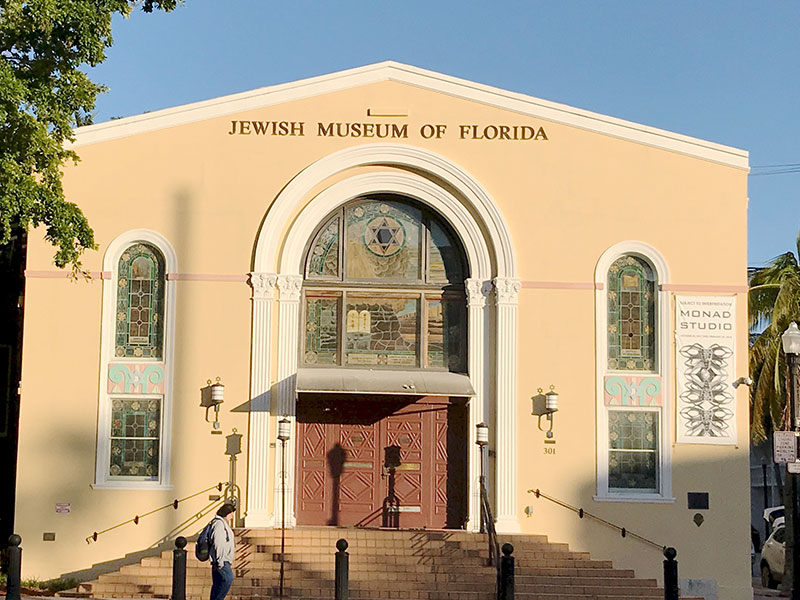I was lucky enough to be in Miami Beach when the arctic cold spell hit Toronto at the beginning of the new year. As it turned out, the weather down south was not particularly good either.
It was too cold to sunbathe and it was often too windy to walk on the beach. Nevertheless I had a great time.
I discovered there’s more to the Miami area than the ocean and the malls.
Miami Beach is actually a cultural centre. Who knew?
The area also has a rich Jewish history, which is no surprise. More than 500,000 Jewish people reside in the vicinity of South Florida and that number swells during the winter.
Aside from the many synagogues and fine kosher restaurants, there’s also a Jewish connection to several important cultural and historical sites in Miami Beach.
My husband and I stayed on Collins Avenue, about a dozen blocks from two landmark hotels – the Fontainebleau and the Eden Roc.
We were not far from an enclave of kosher grocers and restaurants on 41st Street, and we were a short drive from the Harding Street strip in Surfside, which is known for its upscale kosher dining.
Collins Avenue begins in South Beach, a historic district that boasts the world’s largest repository of art deco architecture, the modernist style of the ‘20s and ‘30s.
The area had been in decline since the mid-‘70s, but it has been undergoing a massive restoration for the last 30 years.
Walking in South Beach is like being in an architectural time warp. You pass block after block of pastel-hued art deco buildings accented with neon lights.
Trendy restaurants and outdoor cafes abound, especially on Ocean Drive, a thoroughfare that stretches north along the beach, where throngs of tourists and locals walk, run or ride bikes.
The local Jewish community has had a presence in South Beach since 1913, when the first Jewish residents settled in the area. They were not allowed to live north of 5th Street nor could they build a synagogue until the late ‘20s.
READ: THE CHALLENGES OF TRAVELING ORTHODOX
Beth Jacob (311 Washington Ave.), the first synagogue in Miami Beach, was completed in 1929. The congregation quickly outgrew that space and built an adjacent art-deco, domed structure at 301 Washington Ave. in 1936.
By the ‘80s membership had dwindled and in 1995 the 1936 building became the Jewish Museum of Florida- Florida International University (jmof.fiu.edu). It annexed the older synagogue in 2008.
The museum offers lectures, Jewish-themed walking tours and a display of items from its permanent collection.
There are also two short-term exhibitions: 3D printer sculptures by Eric Goldemberg and Veronica Zalcberg ends Feb. 25, while Pointing the Way: The Art of the Torah Pointer continues until March 18.
During the ‘60s and ‘70s, South Beach became an inexpensive place to retire and many of these retirees were Jewish.
That era marked the heyday of iconic kosher-style eateries like Wolfie’s and Wolfie Cohen’s Rascal House, which no longer exist.
These colourful establishments were known for their legendary large portions and the early-bird specials (reduced-priced meals served from 3 to 6 p.m,), which were geared to their frugal elderly Jewish patrons.
The Wolfsonian (1001 Washington Ave.), a museum in heart of South Beach that specializes in art and design, was founded in 1986 by philanthropist Mitchell Wolfson Jr. His father, Mitchell Wolfson, was the first Jewish mayor of Miami Beach.
The permanent collection focuses on objects produced from 1880s until the mid-’50s, a time span encompassing art nouveau and art deco.
The Julius Klinger exhibit, Posters for a Modern Age, is on at the Wolfsonian until April 29.

Klinger (1876-1942), was a Jewish Austrian graphic artist, who was known worldwide for his innovative advertising posters and book and magazine illustrations.
His career ended with Germany’s annexation of Austria in 1938. Klinger was subsequently forbidden to work because he was Jewish. He died in an extermination camp in 1942.
On an evening walk we came across Urban Legends, an exhibition featuring such popular “graffiti-street” artists as Banksy and MrD1987. The show has been mounted in the lobby of the Sagamore Hotel (1671 Collins Ave.) and runs until March 1.
Not to be missed is the moving Miami Beach Holocaust Memorial at Meridian Avenue and Dade Boulevard, a few blocks northwest of South Beach.
This monumental circular structure of hewn Jerusalem stone was designed by Kenneth Treister, an architect and sculptor. Since its completion in 1990, the memorial has been open 24/7.

Its focal point is Treister’s Sculpture of Love and Anguish, a gigantic arm reaching upwards. Dozens of entwined bodies cling to this outstretched arm tattooed with a number.
The memorial is also characterized by a huge reflecting pool and a circular wall inscribed with the names of Holocaust victims.
Miami Beach Botanical Gardens is located just behind the memorial. There’s no charge for admission to this tranquil tropical oasis.
